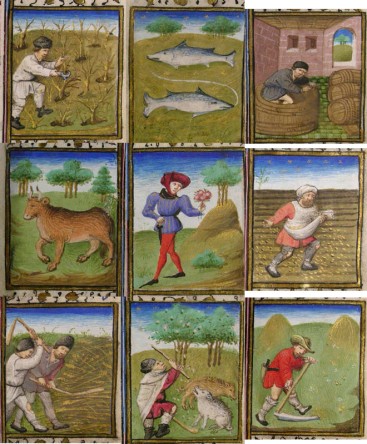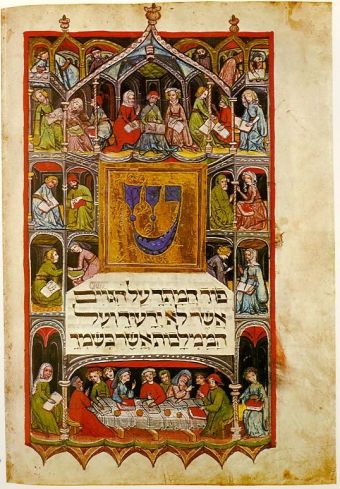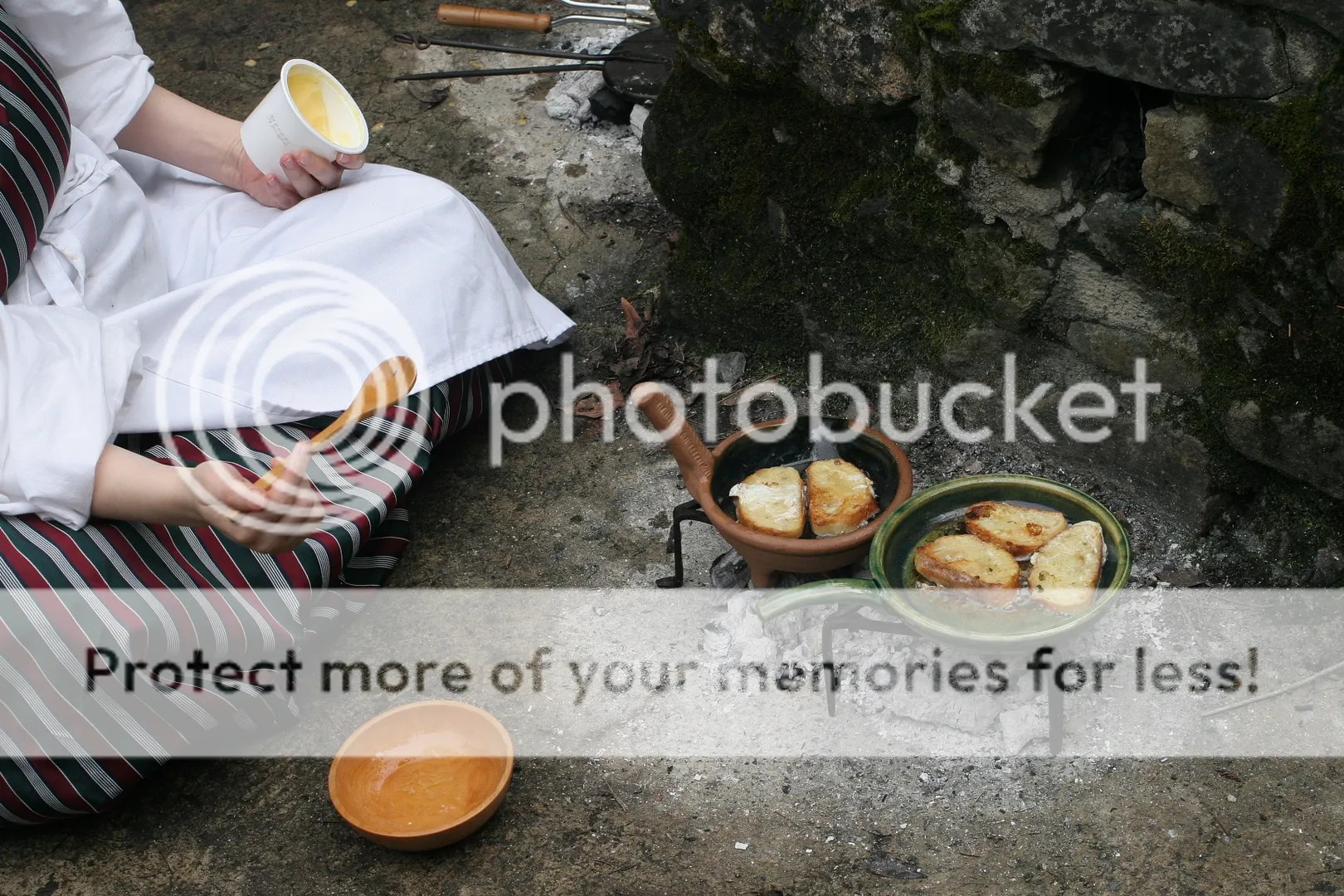Another post from our guest blogger THL Johnnae llyn Lewis, CE
Now welcome, somer, with thy sonne softe,
Chaucer. The Parliament of Fowls. c. 1381
Among the oft-repeated instructions for carving and serving of various dishes and meats, Wynkyn de Worde’s The Boke of Keruynge (Book of Carving) of 1508 contains suggested menus, which divide the season of Summer into two parts. The first part is from the Feast of Pentecost until Midsummer with the second being from Midsummer to Michaelmas. For those us living in the 21st century who commonly think of Summer as the season between Memorial Day to Labor Day or more formally the days between the Summer Solstice to the Autumnal Equinox (or quite frankly those days between the end of the school year to the start of the school year), it might seem odd to think of Midsummer as being a specific date, but it is and was. Midsummer is also known as St. John’s Day, celebrating the nativity and feast day of St. John the Baptist. The solstice may vary between June 20th and
 June 22nd. St John’s Day is June 24th with St. John’s Eve being June 23rd. So yes, Midsummer occurs just a few days after the Summer solstice! By tradition Midsummer was a time of revelry and bonfires. Shakespeare even has Olivia in the play Twelfth Night say, “Why, this is very midsummer madness,” knowing his audience would be well aware of the merriment of a Midsummer eve and day.
June 22nd. St John’s Day is June 24th with St. John’s Eve being June 23rd. So yes, Midsummer occurs just a few days after the Summer solstice! By tradition Midsummer was a time of revelry and bonfires. Shakespeare even has Olivia in the play Twelfth Night say, “Why, this is very midsummer madness,” knowing his audience would be well aware of the merriment of a Midsummer eve and day.
Among the foods for late Spring until early Summer mentioned in the 1513 edition of The Boke of Keruynge, we find “befe, motton, capons” (which might be sodden or rosted), “Iussell charlet or mortrus with yonge geese, vele, porke, pygyons or chekyns rosted with payne puffe. …Here endeth the feest from Pentecost to mydsomer.” The suggested foods for “the feest of saynt Iohn̄ the baptyst vnto Myghelmasse” include
“ potage, wortes, gruell, & fourmenty with venyson and mortrus and pestelles of porke with grene sauce.” Then follows: “Rosted capon, swanne with chawdron.” There follows “ potage,” “rosted motton, vele, porke,” and a selection of fowl, including “chekyns or endoured pygyons, heron.” Then come the “fruyters or other bake metes.”
The Boke of Keruynge. [London: Wynkyn de Worde, 1508, 1513.]
This advice regarding serving and carving of various foods along with the menus given in The Boke of Keruynge would be repeated in later cookery English books well into the late 17th century. Thomas Dawson in the late 16th century would repeat the same advice in The Second Part of the Good Hus-wiues Iewell. Dawson also includes this “goodlye” recipe which mentions summer.
A goodlye secret for to condite or confite Orenges, citrons, and all other fruites in sirrop.
Take Cytrons and cut them in peeces, taking out of them the iuice or substance, then boyle them in freshe water halfe an hower vntill they be tender, and when you take them out, cast thē in colde water, leaue them there a good while, thē set them on the fire againe in other freshe water, doo but heat it a little with a smal fire, for it must not seeth, but let it simper a litle, continue thus eight daies together heating thē euery day in hot water: some heat ye water but one day, to the end that the citrons be not too tender, but change
the freshe water at night to take out the bitternesse of the pilles, the which being taken away, you must take suger or Hony clarified, wherein you must the citrons put, hauing first wel dried them from the water, & in wīter you must kéep thē from the frost, & in Sommer you shal leaue thē there all night, and a daye and a night in Honie, then boile the Honie or Sugar by it selfe without the orenges or Citrons by the space of halfe an hower or lesse with a little fire, and beeing colde set it again to the fire with the Citrons, continuing so two morninges: if you wil put Honnie in water and not suger, you must clarifie it two times, and straine it through a strayner: hauing thus warmed and clarified it you shall straine and sette it againe to the fire, with Citrons onely, making them to boyle with a soft fire the space of a quarter of an houre, thē take it from the fire & let it rest at euery time you do it, a day & a night: the next morning you shall boyle it again together the space of half an how¦er, and doo so two morninges, to the end that the Honie or suger may be well incorporated with the Citrons. All the cunning consisteth in the boyling of this sirrope together with the Citrons, and also the Sirrope by it selfe, and heerein heede must be taken that it take not ye smoke, so that it sauour not of the fire: In this maner may be drest the Peaches, or Lemmons Orrenges, Apples, greene Walnuts, and other liste being boiled more or lesse, according to the nature of the fruits.
Dawson, Thomas. The Second Part of the Good Hus-wiues Iewell. London: 1597.
Also printed in the 1590s was The Good Huswiues Handmaid, for Cookerie in her Kitchin in dressing all maner of meat, with other wholsom diet, for her & her houshold. &c. This work offers a recipe for summer chicken pies.
To bake chickins in Summer.
CVt off their feete, trusse them in the coffins. Then take for euerie Chicken a good handfull of Gooseberries, and put into the pie with the Chickens. Then take a good quantity of butter, and put about euerie chicken in the pie. Then take a good quantitie of Sinamon, and ginger, and put it in the pie with salt and let them bake an houre, when they be baked, take for euerie pie the yolke of an eg, and halfe a goblet full of vergious and a good quantie of sugar, and put them altogether into the pie to the chickens, and so serue them. Page 20
Contrast with
To bake chickens in winter.
CVt of their feete, and trusse them, and put them in the pies, take to euerie pie a certaine of Corrans or Prunes, and put them in the pie with the Chickens. Then take a good quantity of Butter to euerie chicken, and put in the pie: then take a good quantity of ginger, and salt and season them together, & put them in the pie, let it bake the space of an houre & a half, whē they be baken, take sauce as is afore said, and so serue them in. Page 20
The Good Huswiues Handmaid also includes this recipe for a manchet, which notes differences between summer and winter baking.
The making of manchets after my Ladie Graies way.
Take two pecks of fine flower, which must be twise boulted, if you will haue your manchet very faire: Then lay it in a place where ye doe vse to lay your dowe for your bread, and make a litle hole in it, and take a quart of fair water blood warme, and put in that water as much leauen as a crab, or a pretie big apple, and as much white salt as will into an Egshell, and all to breake your leuen in the water, and put into your flower halfe a pinte of good ale yest, and so stir this liquor among a litle of your flower, so that ye must make it but thin at the first meeting, and then couer it with flower, and if it be in the winter, ye must keep it very warm and in summer it shall not need so much heate, for in the Winter it will not rise without warmeth. Thus let it lie two howers and a halfe: then at the second opening take more liquor as ye thinke will serue to wet al the flower. Then put in a pinte and a halfe of good yest and so all to breake it in short peeces, after yee haue well laboured it, and wrought it fiue or sixe tymes, so that yee bee sure it is throughlie mingled together, so continue labouring it, til it come to a smooth paste, and be well ware at the second opening that ye put not in too much liquor sodenlie, for then it wil run & if yee take a litle it wil be stiffe, and after the second working it must lie a good quarter of an houre, and kéep it warme: then take it vp to the moulding board, and with as much spéede as is possible to be made, mould it vp, and set it into the ouen, of one pecke of flower ye may make ten cast of Manchets faire and good. Page 51-52.
The good Huswiues Handmaid. [Sometimes cited as: A Booke of Cookerie, otherwise called the good huswiues handmaid.] [London] : [E. Allde, 1597]
The 1598 Epulario, or The Italian Banquet also includes a few recipes which mention Summer. Here we find a recipe for a sweetmeate and a recipe for the color blue.
To make a kind of Leach.
Take the yolkes of foure egges, halfe an ounce of Sinamon, foure ounces of Sugar, two ounces of Rosewater, and foure ounces of the iuice of Orenges, beate all these thinges together, and boile them and make it somewhat yellow, this is common in summer time.
To make a skie colour sauce in summer.
Take wild mulberies which grow in the Hedges, and a few stamped Almonds with a little Ginger, temper all this with Veriuice and straine it.
Epulario, or The Italian banquet. London: 1598.
Likewise, John Partridge offers up a seasonal recipe for a rose vinegar.
To make Uineger of Roses. Chapter. viii.
IN Sommer time when Roses blowe, gather them ere they be full spred or blowne out, and in dry wether: plucke the leaues, let them lye halfe a day vpon a fayre borde, then haue a vessel with Uineger of one or two gallons (if you wyll make so much roset,) put therein a great quantity of the sayd leaues, stop the vessell close after that you haue styrred them wel together, let it stand a day and a night, then deuide your Uineger & Rose leaues together in two parts put the in two great Glasses & put in Rose leaues ynoughe, stop the Glasses close, set them vpon a Shelfe vnder a wall syde, on the Southside wtout your house where the Sonne may come to them the most parte of the daye, let them stande there all the whole Somer longe: and then strayne the vineger from the Roses, and keepe the vinegre. If you shall once in .x. dayes, take and strain out Rose leaues, and put in newe leaues of halfe a dayes gatheryng, the vyneger wyll haue the more flauor and odour of the Rose.
You may vse in steede of Uinegre, wyne: that it may wexe eygre, and receiue ye vertue of the Roses, both at once. Moreouer, you may make your vineger of wine white, red, or claret, but the red doth most binde the bellie, & white doth most lose. Also the Damaske Rose is not so great a binder as the red Rose, and the white Rose loose th most of all: wereof you may make vinegre roset.
Thus also, you may make Uinegre of Uiolets, or of Elder flowers: but you must first gather & vse your flowers of Eldern, as shalbe shewed hereafter, when we speake of makyng Conserue of Elderne flowers.
Partridge, John. The Treasurie of commodious Conceits.1573**
Although his works are published in the early 1600s, the author John Murrell is worth mentioning because this work distinctly mentions “Summer” on the work’s actual title page. It reads:
“A NEVV BOOK OF COOKERIE.
Wherein is set forth a most perfect direction to furnish an extraordinary, or ordinary-feast, either in Summer or Winter.”
Then on page one, we are told:
“BY reason of the generall ignorance of most men in this practise of Catering. I haue set downe here a perfect direction how to set forth an extraordinary Dyet for the Summerseason, when these things mentioned may easily be had.”
Page 2 promises:
“Also, another Direction for another seruice for the Winter season, of twenty Dishes to the first Messe, and as many to the second Course to the same messe: so that in al there be forty Dishes to the messe although it be contrary to the other seruice of the Summer season.”
He then provides this bill of fare, which would indeed provide an extraordinary meal:
“A Bill of service for an extraordinary Feast for Summer season, 50. dishes to a Messe.
- A Grand Sallet. 2 A boyld Capon. 3 A boyld Pike. 4 A dish of boyld Pea-chickens, or Partriges, or young Turky chicks. 5 A boyld Breame. 6 A dish of young Wild-ducks. 7 A dish of boyld Quailes. 8 A Florentine of Pufpaste. 9 A forc’d boild meat. 10 A hansh of Venison roasted. 11 A Lombar Pye. 12 A Swan. 13 A Fawne or Kid, with a Pudding in his belly, or for want of a Fawne you may take a Pigge and fley it. 14 A Pasty of Venison. 15 A Bustard. 16 A Chicken Pye. 17 A Pheasant or Powtes. 18 A Potato Pye. 19 A Couple of Caponets. 20 A set Custard.
The second Course.
- A Quarter of a Kid. 2 A boyld Carpe. 3 A Heron or Bitter. 4 A Congers head broyled, or Trouts. 5 A Hartichoake pie. 6 A dish of Ruffs or Godwits. 7 A cold bak’d meate. 8 A sowst pigge. 9 A Gull. 10 A cold bak’d meat. 11 A sowst pike, Breame, or Carp. 12 A dish of partriges. 13 An Orengado pye. 14 A dish of Quailes. 15 A cold bak’d meate. 16 A fresh Salmon, pearch or Mullet. 17 A Quodling Tart, Cherry, or Goosebery Tart. 18 A dryed Neates-tongue. 19 A Iole of Sturgeon. 20 A sucket Tart of pufpaste.
The third Course for the same Messe.
1 A Dish of Pewets. 2 A Dish of Pearches. 3 A dish of gréen Pease, if they be dainty. 4 Dish of Dotrels. 5 A dish of Hartichoakes. 6 A dish of buttered Crabs. 7 A dish of Prawnes. 8 A dish of Lobstars. 9 A dish of Anchoues. 10 A dish of pickled Oysters.
Murrell, John. Murrels tvvo books of cookerie and carving. (This combined late edition is dated 1641.)
Lastly, a search through the early English cookery books printed prior to 1700 finds that the work with the most recipes mentioning the season of Summer appears to be Robert May’s 1660 classic cookery book The Accomplisht Cook, or The Art and Mystery of Cookery. May, who was born in 1588, includes recipes for alternative summer versions of recipes for pigeons, fillet of beef, mutton, veal, sturgeon, lobsters, bisk or Battalia pie, and “Paste for made dishes in summer.” I will end by mentioning the 1608 The Closet for Ladies and Gentlewomen***. The work may not directly mention the season of Summer, but the work is worth examining for its numerous recipes for confections, pastes, and waters made of flowers and herbs, all suitable for summer feasts and banquets. Happy Summer, Everyone.
Sources are as indicated.
For more on Robert May, see:
Holloway, Johnna. “An Appreciation of Robert May.” Tournaments Illuminated. #188. 4th quarter. 2013. pp 25-27, 32.
** Partridge, John. The Treasurie of commodious Conceits of 1573 may be found online in a transcription © 2010 by Johnna Holloway. Web. Medieval Cookery.com. http://www.medievalcookery.com/notes/treasurie.pdf
***The Closet for Ladies and Gentlewomen of 1608 may be found online in an edited and annotated edition © 2011 by Johnna Holloway. Web. Medieval Cookery.com. http://www.medievalcookery.com/notes/1608closet.pdf
©Holloway 2015, 2018.












You must be logged in to post a comment.